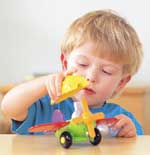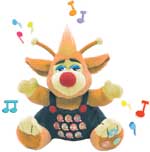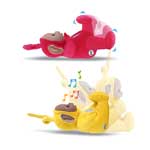|
|||
| Introduction | |||
| Childhood games and toys | |||
| TOYS AND THE CHILD’S PHYSICAL AND PSYCHOLOGICAL DEVELOPMENT
Whenever we talk about the particularities of toys, their effects and relationships with the development of children, they are invariably linked to the significance of play, because the elaboration of these objects is generally conceived taking into account this link. This way, for example, J. Piaget establishes his well known classification of games. In it, he specifies that games can be functional, construction, of rules, of roles, and didactic, although these last ones do not really constitute a category in themselves , but one that is related to the rest of them. Using this classification of games as a base for our study, an identical one is organized when it comes to toys. Then we can talk about functional, construction, roles, rules and didactic toys. These toys have certain contents, educational functions and action patterns, closely related to the development of the games, and they are materialized in certain types of objects that also have these features. This way, the toy appears as something without significance in itself, as an object of reality, and its effects on physical and psychological development are only valued taking into account what the game provides. To is acceptable to a point, but it limits the knowledge of the real possibilities of the toy for the development of children, because it is always related to the situation of play. And although play is the most important activity of pre-scholers, it is not the only activity that children carry out. and in which toys, as objects of reality also exert a stimulating action over the different processes and psychic properties, although they are not used within a play activity.
For example, when a nursing child manipulates any object, for example a ball (that it is generally considered a toy) and he carries out several repetitive actions with it, this is not really a game, since such actions only allow the child to know the object, its particularities and properties, and not to derive enjoyment from it. This first phase of the activity with objects is what usually is known as manipulation of objects, and it is always directed to the knowledge of their external characteristics. It is not being used as part of a game but it has fostered the stimulation of diverse processes and psychic qualities, such as perceptual discrimination and differentiation, concentration of the attention, generalization of relationships, reasoning. In short, it has had an important effect when it comes to the development of the child. If this is or not considered play is a historical discussion within the field of psychology. But what is important now is to notice that the possibilities of toy for development are not linked to the play activity in itself, but rather they go further on, to the group of all the activities that children carry out in their evolution. And that, therefore, their study must not only be connected to the objectives of play, but to the most varied activities that children carry out, and consequently, referred to all their qualities and psychological and physical processes. And this enlarges the viability of the toy as a mean to promote child development.
This way the purpose of a toy is to stimulate the activity and the initiative of children, facilitating the most diverse psychological processes and qualities, as well as motor dexterities. They are developed in connection with the intrinsic particularities of each toy and what it fundamentally promotes in each psychological or physical action. It is necessary to point out the "fundamental" aspect that each toy develops, to highlight that in an object-toy is not only established the psychical action that is its main function, but also other ones that have an effect, although it is not so outstanding in some cases. In the case of the previously mentioned ball, although it is obvious that its main purpose is to activate thick motor activity and the movements of the hand; it also acts over the perception of the shape, tactile sensibility, visual discrimination, among other properties. It avoids to consider a type of toy for a certain particularity of development, but rather it embraces a wide range of stimulation possibilities. The main aim of toys is also to offer children the opportunity to express and to put into practice the new abilities acquired in the successive phases of the normal development, in particular in the infantile stage in which play is the fundamental activity and a substantial part of the stage in which they are brought up, becoming a basic tool of their educational process. |
||||||||||||||


